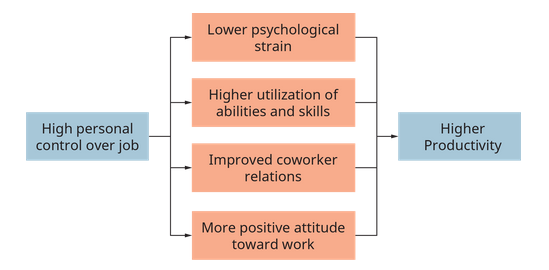2.5 Type A/B Personality
Learning Objectives
- Explore A/B personality theory.
- Consider how to work across personality types.
Type A Personality
Research has focused on what is perhaps the single most dangerous personal influence on experienced stress and subsequent physical harm. This characteristic was first introduced by Friedman and Rosenman and is called Type A personality.[1]

Type A and Type B personalities are felt to be relatively stable personal characteristics exhibited by individuals. Type A personality is characterized by impatience, restlessness, aggressiveness, competitiveness, polyphasic activities (having many “irons in the fire” at one time), and being under considerable time pressure. Work activities are particularly important to Type A individuals, and they tend to freely invest long hours on the job to meet pressing (and recurring) deadlines. Type B people, on the other hand, experience fewer pressing deadlines or conflicts, are relatively free of any sense of time urgency or hostility, and are generally less competitive on the job. These differences are summarized in Table 3[2].
| Type A | Type B |
|---|---|
| Highly competitive | Lacks intense competitiveness |
| “Workaholic” | Work only one of many interests |
| Intense sense of urgency | More deliberate time orientation |
| Polyphasic behaviour | Does one activity at a time |
| Strong goal-directedness | More moderate goal-directedness |
Type A personality is frequently found in managers. Indeed, one study found that 60 percent of managers were clearly identified as Type A, whereas only 12 percent were clearly identified as Type B.[3]
It has been suggested that Type A personality is most useful in helping someone rise through the ranks of an organization.
The role of Type A personality in producing stress is exemplified by the relationship between this behaviour and heart disease. Rosenman and Friedman studied 3,500 men over an 8 1/2-year period and found Type A individuals to be twice as prone to heart disease, five times as prone to a second heart attack, and twice as prone to fatal heart attacks when compared to Type B individuals.[4]
Similarly, Jenkins studied over 3,000 men and found that of 133 coronary heart disease sufferers, 94 were clearly identified as Type A in early test scores.[5]
The rapid rise of women in managerial positions suggests that they, too, may be subject to this same problem. Hence, Type A behaviour very clearly leads to one of the most severe outcomes of experienced stress. One irony of Type A is that although this behaviour is helpful in securing rapid promotion to the top of an organization, it may be detrimental once the individual has arrived. That is, although Type A employees make successful managers (and salespeople), the most successful top executives tend to be Type B. They exhibit patience and a broad concern for the ramifications of decisions. As Dr. Elmer Green, a Menninger Foundation psychologist who works with executives, notes, “This fellow—the driving A—can’t relax enough to do a really first-rate job, at the office or at home. He gets to a level that dogged work can achieve, but not often to the pinnacle of his business or profession, which requires sober, quiet, balanced reasoning.”[6]
The key is to know how to shift from Type A behaviour to Type B.
How does a manager accomplish this? The obvious answer is to slow down and relax. However, many Type A managers refuse to acknowledge either the problem or the need for change, because they feel it may be viewed as a sign of weakness. In these cases, several small steps can be taken, including scheduling specified times every day to exercise, delegating more significant work to subordinates, and eliminating optional activities from the daily calendar. Some companies have begun experimenting with retreats, where managers are removed from the work environment and engage in group psychotherapy over the problems associated with Type A personality. Initial results from these programs appear promising.[7] Even so, more needs to be done if we are to reduce job-related stress and its serious health implications.
Chapter adapted from 18.2 Organizational Influences on Stress in OpenStax Organizational Behavior. CC BY license.
- M. Friedman and R. Rosenman, Type A Behavior and your Heart (New York: Knopf, 1974). ↵
- Attribution: Copyright Rice University, OpenStax, under CC BY-NC-SA 4.0 license) ↵
- J. Howard, D. Cunningham, and P. Rechnitzer, “Health Patterns Associated with Type A Behavior: A Managerial Population,” Journal of Human Stress, 1976, pp. 24–31. ↵
- Friedman and Rosenman, op. cit. ↵
- C. Jenkins, “Psychologic Disease and Social Prevention of Coronary Disease,” New England Journal of Medicine, 1971, 284, pp. 244–255; T. Beehr and R. Bhagat, Human Stress and Cognition in Organizations: An Integrated Perspective (New York: Wiley, 1985). ↵
- Business Week, October 17, 1977, p. 137. ↵
- Ibid. ↵
Type A personality is characterized by impatience, restlessness, aggressiveness, competitiveness, polyphasic activities, and being under considerable time pressure.

